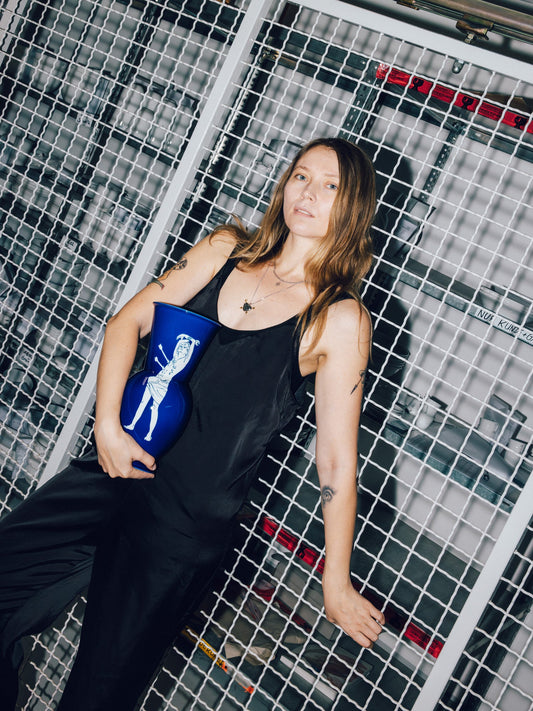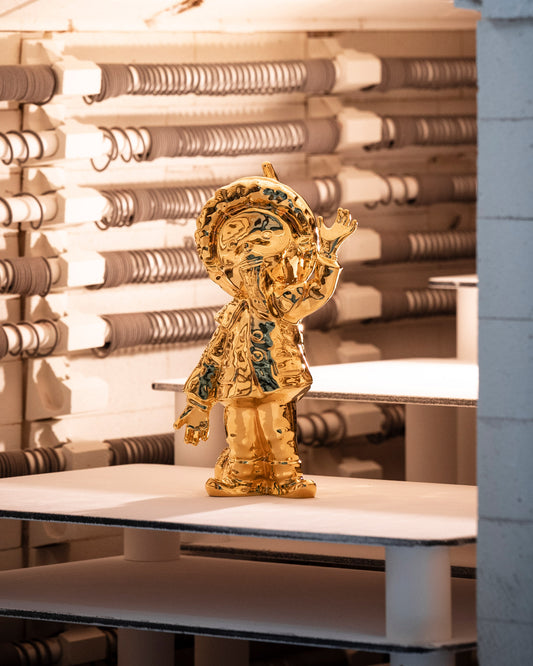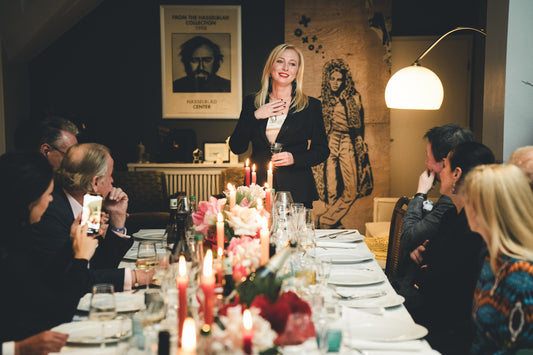"I AM LOOKING FOR A CHALLENGE"
As head designer at the Königliche Porzellan-Manufaktur, Thomas Wenzel has been developing products for almost 30 years that are designed to preserve tradition while still being contemporary. For some KPM aficionados, this can be a source of debate. In an interview with Heike Gläser for the KPM customer magazine WEISS Nº 1, the designer reveals how he came to the Berlin manufactory and what fascinates him every day.
Holger Talinski
Thomas Wenzel starts where others give up. The head designer at KPM Berlin is looking for a challenge. "If someone says something can't be done or is too complicated, then I get curious," he says. In this respect, a material that is not so easy to work with, such as porcelain, is just right for him. It fascinates him. He is convinced that it is a living material, that it has a soul: "Porcelain is a bitch." Behaves like a diva. It doesn't forgive mistakes and you can't get away with everything with it. He talks about porcelain as if it were a creature that is always good for a surprise.
His studio is located - somewhat hidden - on a mezzanine floor of the manufactory, with the porcelain painters above and the management and trainees below. It is bright and light, a wall has just been broken through to give him more space for his designs, which he works on with an assistant and a trainee. Wenzel prefers to talk standing up, walks around, leans against the edge of the table and picks up his latest notes. He is currently working on his LAB BERLIN series, a collection of pieces with clear lines and shapes, inspired by the laboratory porcelains from times gone by that are still in the manufactory. He is reinterpreting them, adapting them to contemporary tableware and also designing products for the kitchen, such as a mortar with a heavy pestle or a lemon squeezer that looks like a sculpture and which he will probably be tinkering with for some time before it can be produced.
Wenzel was born in Gera in 1963, attended the University of Applied Arts in Schneeberg and then completed his training as a porcelain painter. In 1989, he came to Berlin to join KPM, before which he was employed at Meissen. The 54-year-old has now been working at KPM for more than half of his life. He progressed from porcelain painter to master painter and finally became head designer in 1998. KPM was actually only supposed to be a stopover for him, but then he got stuck, "because there was so much to do here," he recalls of the early years. Back then, there was no in-house development. This was to change with Thomas Wenzel, who became head of the artistic development department at KPM in 1993. During this time, the internationally renowned designer Enzo Mari also joined the manufactory for five years. It was a good and instructive time for Thomas Wenzel, during which he worked with Mari to launch the BERLIN shape, for example, which later won the iF Design Award.
In addition to the famous currywurst bowl with KURLAND relief and the KURLAND cereal, the KURLAND BLANC NOUVEAU service can also be traced back to his development work. He designed it on the occasion of KPM's 250th anniversary. There was always resistance to such innovations from regular customers who, for example, struggled with the latte cup cup in KURLAND design. Wenzel doesn't mind:
The best products are the ones that are discussed the most.
He describes his working method as "solution-oriented", for example when it comes to the idea of producing colored masses. About four years ago, he noticed that "pastel colors are a very beautiful theme". He spent a long time tinkering and thinking about the methods and limits of the material until he was able to implement double mass casting with white and mint-colored porcelain. The porcelain is not glazed in color, but fired in colored porcelain and then glazed. With this so-called bicolor process, which he likes to use for the LAB series, he succeeds in two things: maintaining the high quality and standard of KPM porcelain and at the same time achieving a further unique selling point within the product range. He also came up with another innovation: no longer hiding the distinctive KPM label with the blue sceptre at the bottom of the cups, pots or plates, but making it visible and using it as a design element to set the scene.
Thomas Wenzel hardly ever works on a computer. When he comes up with something, he draws it by hand, first a rough sketch, then more detailed drawings. This is also how the double-walled thermal coffee filler was created, which won the internationally coveted iF Gold Award in the "Product" category in 2016. This surprised him himself. "I didn't expect such appreciation," he says. Thomas Wenzel's functional and visual overall concept won over the jury. In its statement, it said: "It's great to see that Royal Porcelain Manufactory Berlin is back in the game - with a completely new and innovative perspective on a low-tech product like the coffee filter."
And indeed, KPM is back in the game. For some years now, something has been happening at the porcelain manufactory, which can look back on more than 250 years of tradition and has always made great efforts in the past to preserve and continue the old, from the classicist KURLAND service to Bauhaus-inspired shapes such as URBINO or ARKADIA. But now there are the first signs of a move away from Prussian austerity towards contemporary forms that fit into the 21st century. This is partly due to Jörg Woltmann, who saved KPM from insolvency a good ten years ago, but also to Thomas Wenzel, who enjoys Woltmann's trust and knows how to balance the fine line between the legacy of the past and the path to the future. He starts where others give up.
Text: Heike Gläser
Wenzel's works
These products from Thomas Wenzel are causing a stir and winning designer awards.


